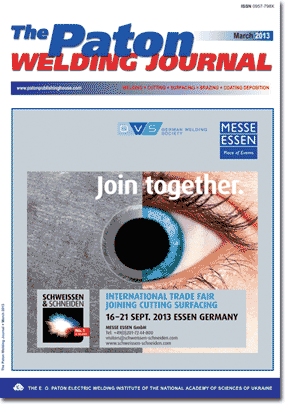| 2013 №03 (02) | 2013 №03 (04) |

The Paton Welding Journal, 2013, #3, 14-17 pages
SIMPLIFIED ANALYTICAL MODELING OF DYNAMIC BEHAVIOR OF THE KEYHOLE FOR DIFFERENT SPATIAL LASER INTENSITY DISTRIBUTIONS DURING LASER DEEP PENETRATION WELDING
J. VOLPP, M. GATZEN and F. VOLLERTSEN
BIAS Е Bremer Institut fuer Angewandte Strahltechnik GmbH, Bremen, Germany
Abstract
During laser deep penetration welding a characteristic keyhole is created, when the intensity of laser beam exceeds material depending limit. The generated system of keyhole and surrounding melt pool is highly dynamic. Dynamics in the weld pool and in keyhole are mainly responsible for keyhole instabilities that can cause keyhole collapses during the welding process. This can lead to unwanted enclosures or pores that reduce the quality of welded joint. For better understanding of the complex system, a simplified analytical model of the keyhole is used providing a description of the keyhole geometry. It also calculates the influence of different spatial laser intensity distributions on keyhole dynamics and resultant tendency to form pores. The model is used to calculate the temperature on the keyhole wall from energy equation containing laser beam energy absorption, heat conduction and evaporation losses. The surface temperature is needed to calculate the keyhole radius by solving the pressure equilibrium equation. This contains the recoil pressure at the end of the Knudsen layer on the keyhole surface, which keeps the keyhole open against the surface tension pressure of the surrounding liquid material. In the second step, a dynamic equation that describes the keyhole behavior is used. The dynamic calculation is based on the force balance in the keyhole. To observe the influence of different spatial laser intensity distributions the Gaussian and top hat distribution are implemented in calculation. It can be found that the keyhole geometry is influenced by different laser intensity distributions and pressure gradient changes significantly leading to highly different dynamic behaviors. 18 Ref., 2 Figures.
Keywords: laser welding, deep penetration, keyhole, radiation intensity, spatial radiation, analytical model, keyhole geometry, weld metal, pore formation
Received: 16.01.13
Published: 28.03.13
References
1. Tsukamoto, S., Arakane, G., Kojima, K. et al. (2007) Effect of alloying elements on porosity formation in laser welding of heavy section steel plates. IIW Doc. IV-941-07.
2. Szymanski, Z., Hoffman, J., Kurzyna, J. (2001) Plasma plume oscillations during welding of thin metal sheets with a CW CO2 laser. J. Phys. D: Appl. Phys., 34, 189-199.
3. Matsunawa, A., Kim, J.D., Katayama, S. et al. (1996) Experimental and theoretical studies on keyhole dynamics in laser welding. In: 15th ICALEO Proc. (14-17 Oct. 1996, Detroit, USA), 81, 58-67.
4. Berger, P., Hugel, H., Graf, T. (2011) Understanding pore formation in laser beam welding. Physics Procedia, 12, 241-247.
5. Liu, L., Song, G., Liang, G. et al. (2005) Pore formation during hybrid laser-tungsten inert gas arc welding of magnesium alloy AZ31B Е Mechanism and remedy. Materials Sci. and Eng. A, 390, 76-80.
6. Semak, V., Hopkins, J., McCay, M. et al. (1995) Melt pool dynamics during laser welding. J. Phys. D: Appl. Phys., 28, 2443-2450.
7. Klassen, M. (2000) Prozessdynamik und resultierende Prozessinstabilitaeten beim Laserstrahlschweissen von Aluminiumlegierungen: PhD thesis, University of Bremen.
8. Ki, H., Mohanty, P., Mazumder, J. (2002) Modeling of laser keyhole welding. Pt I: Mathematical modeling, numerical methodology, role of recoil pressure, multiple reflections, and free surface evolution. Metallurg. and Mater. Transact., 33, June.
9. Pitz, I., Otto, A., Schmidt, M. (2011) Accelerated simulation of laser beam forming by means of moving meshes. In: IWOTE Proc. (Bremen, April 6-7, 2011).
10. Kroos, J., Gratzke, U., Simon, G. (1993) Towards a self-consistent model of the keyhole in penetration laser beam welding. J. Phys. D: Appl. Phys., 26, 474-480.
11. Pleteit, H. (2001) Analyse und Modellierung der Keyhole-Dynamik beim Laserstrahlschweissen von Aluminiumlegierungen: PhD thesis, University of Bremen.
12. Kaplan, F. (2011) Influence of the beam profile formulation when modeling fiber-guided laser welding. J. Laser Appl., 23(4), Nov.
13. Marten, O., Wolf, S., Hansel, K. et al. (2010) Qualifizierung von Fokussier- und Abbildungssystemen fur die industrielle Laserbearbeitung mit brillanten Strahlquellen im Multikilowattbereich. In: Laser-Anwenderforum Proc. (Bremen, 24-25 Nov., 2010).
14. Khan, M., Romoli, L., Dini, G. et al. (2011) A simplified energy-based model for laser welding of ferritic stainless steels in overlap configurations. CIRP Annals E, 60(1), 215.
15. Schmidt, M., Otto, A., Kageler, C. et al. (2008) Analysis of YAG laser lap-welding of zinc coated steel sheets. Ibid., 57(1), 213.
16. Hugel, H., Graf, T. (2009) Laser in der Fertigung: Strahlquellen, Systeme, Fertigungsverfahren. Stuttgart: Vieweg+Teubner.
17. Klein, T., Vicanek, M., Kroos, J. et al. (1994) Oscillation of the keyhole in penetration laser beam welding. J. Phys. D: Appl. Phys., 27(10), 2023-2030.
18. Fabbro, R., Slimani, S., Coste, F. et al. (2005) Study of keyhole behaviour for full penetration Nd: YAG CW laser welding. Ibid., 38, 1881-1887.
